Dec 24, 2025
Dec 24, 2025
From a Beggar to a Prince
The Delhi artists transported (forcibly ?) to Daulatabad by Muhammed bin-Tughlaq took the Sultanate style with them to the north-western Deccan but trade had long exposed the region to western Asia.
The tale of Zafar Khan, the first ruler of Gulbarga, is eminently recitable. According to some accounts, Zafar Khan was a poor laborer who was nominated to the Sultan’s service by his master, who was impressed by his zeal and honesty. Later distinguishing himself in battle, Zafar Khan rose through the ranks to become eventual governor of the province of Daulatabad. With the weakening of power at Delhi, he declared the province independent of central authority and assumed the name of Ala-ud-din Bahman (1347-1358).
Forts and Citadels
|
|
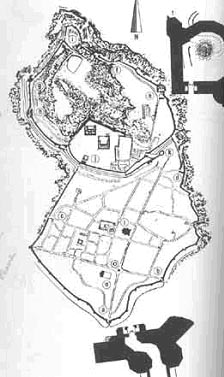 Bidar : Fort and Town Plan |
The Bahmani dynasty’s first citadel, before the capital was shifted to Gulbarga, was at Daulatabad. Here the most prominent feature is the extraordinarily imposing outer walls, in four concentric rings, similar in design and style to the Château Gaillard in France.
The tradition of strong fortifications continued with the shifting of the capital to Gulbarga in 1347. With no natural defense like a hilly site or a river nearby, the Bahmanis instead endowed Gulbarga fort with the Bala Hissar. This massive rectangular keep, citadel within a citadel, was again in the tradition of military architecture inspired by the Crusades in the holy land, and was to remain practically the only example built in India.
The capital of the Bahmani empire was shifted yet again in 1429. This was a strategic decision, as Bidar had a more central position in the kingdom and perhaps more importantly, was out of immediate striking range of the Vijayanagara kingdom, which was a constant menace. In contrast to Gulbarga, Bidar was situated on a sloping promontory, on which were built the fort and its associated town. The fort, naturally, was at the highest level, with its citadel at the northern tip. The fort could be isolated for better defence from the town by a system of gates and moats. Inside the citadel walls, ruins of palaces, mosques and secular structures bear silent witness to a once-powerful empire.
Religion and Death
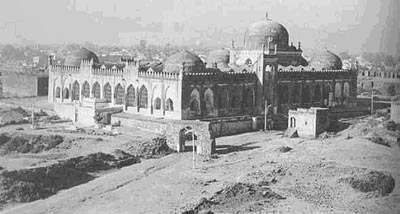 The Bahmani sultans’ Shiite tendencies are clearly reflected in their mosques. These delineate also their Persian origin. For example, the earliest mosque founded in Gulbarga, the Shah Bazaar, is one of the first in India to reflect the Timurid tendency of the multi-bay prayer hall, like at Isfahan in modern Iran. Its most refined expression is then found in the Jami Masjid of Gulbarga.
The Bahmani sultans’ Shiite tendencies are clearly reflected in their mosques. These delineate also their Persian origin. For example, the earliest mosque founded in Gulbarga, the Shah Bazaar, is one of the first in India to reflect the Timurid tendency of the multi-bay prayer hall, like at Isfahan in modern Iran. Its most refined expression is then found in the Jami Masjid of Gulbarga. 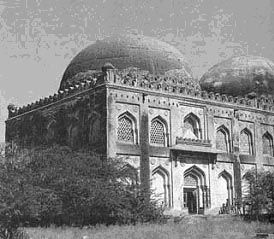 The tombs of the first Bahmani rulers at Gulbarga are fairly simple structures of plastered stone and rubble work.
The tombs of the first Bahmani rulers at Gulbarga are fairly simple structures of plastered stone and rubble work. 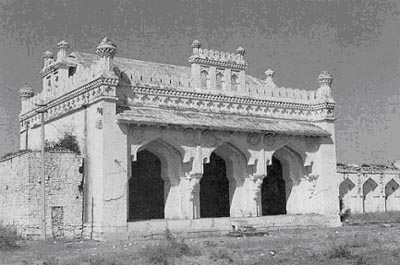 This tendency to fusion with native crafts and motifs reappears very distinctly in the Langar-ki-masjid at Gulbarga, where the outer arches are supported on serpentine columns, and the increasing profusion of decoration is marked.
This tendency to fusion with native crafts and motifs reappears very distinctly in the Langar-ki-masjid at Gulbarga, where the outer arches are supported on serpentine columns, and the increasing profusion of decoration is marked. 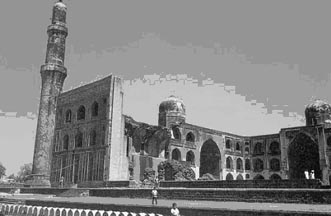 The most striking feature of this structure is its three stories of cells, a most unusual happening in a madrassa. The elevated domes marking the entrances and the imposing minarets combine to make this a high point of the influence of Persian Islamic art and architecture in India.
The most striking feature of this structure is its three stories of cells, a most unusual happening in a madrassa. The elevated domes marking the entrances and the imposing minarets combine to make this a high point of the influence of Persian Islamic art and architecture in India.
23-Feb-2003
More by : Ashish Nangia

|
more necessary for reseaech |